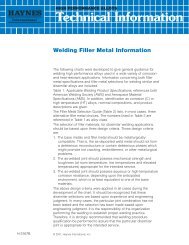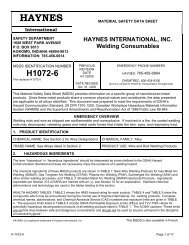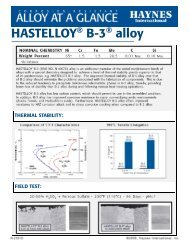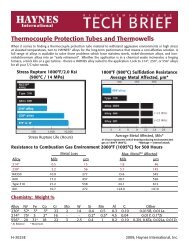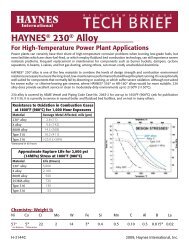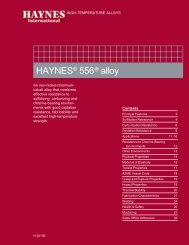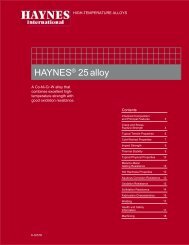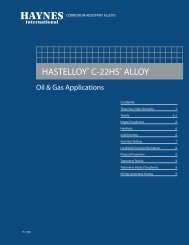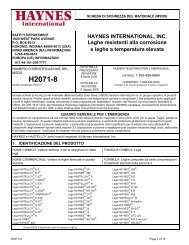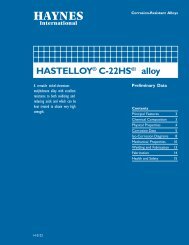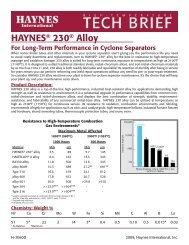P:\P25065\H-# Literature\H-2082 - Haynes International, Inc.
P:\P25065\H-# Literature\H-2082 - Haynes International, Inc.
P:\P25065\H-# Literature\H-2082 - Haynes International, Inc.
- No tags were found...
You also want an ePaper? Increase the reach of your titles
YUMPU automatically turns print PDFs into web optimized ePapers that Google loves.
COMPARATIVE RESISTANCE TO EROSIONErosion Depth/RateCavitation Slurry Solid ParticleAlloy (mm) (microns) (mm 3 /g x 10 4 )ULTIMET ® alloy 0.0068 0.740 10.34HAYNES ® 6B alloy 0.0073 0.460 10.44HAYNES 625 alloy 0.0800 1.660 13.33HASTELLOY ® C-276 alloy 0.1128 1.420 12.65Carpenter 20CB-3 ® alloy 0.2743 1.980 11.06Type 316L Stainless Steel 0.1802 1.310 12.38FERRALIUM ® alloy 255 0.1336 - -Cavitation Test Slurry Test Solid Particle TestPowerSupplyTransducerShaftBaffleGas / Particle StreamHornSampleSampleTest LiquidPropellerExhaustASTM Standard G 32Frequency-20 kHzAmplitude-0.05 mmLiquid-Distilled WaterTest Duration-24 hr.Room TemperatureMedium-80 microns Aluminain Tap WaterVelocity-5 m/sImpact Angle-30°Particle Loading-0.12 kg/lTest Duration-40 hr.Room TemperatureASTM Standard G 76 (Modified)Erodent-400 microns AngularSilicon CarbideVelocity-20 m/sImpact Angle-60°Total Flow-80 g of ErodentRoom TemperatureULTIMET ® alloy 4
COMPARATIVE RESISTANCE TO GALLINGGalling TestLoad100Galling Test (2722 kg/6000 lb. Load)Room TemperatureVS. SELFPinDegree of Damage (µm)80604020VS. 304VS. 410VS. C-276Block10 strokes / 120° arc0STELLITE 1* STELLITE 21* STELLITE 6* ULTIMET*GTA 2-layer depositDegree of Damage, microns Load1361 kg 2722 kg 4082 kgPin Block (3000 lb) (6000 lb) (9000 lb)ULTIMET ® alloy ULTIMET alloy 2.9 2.7 2.0ULTIMET alloy 1045 Carbon Steel (HRC 32) 7.4 6.6 8.2ULTIMET alloy 4140 Alloy Steel (HRC 46) 2.3 2.7 2.5ULTIMET alloy H-13 Tool Steel (HRC 48) 2.1 2.1 2.0ULTIMET alloy Type 304 Stainless Steel 2.5 5.5 18.3ULTIMET alloy Type 316L Stainless Steel 1.4 1.2 0.7Type 316L Stainless Steel Type 316L Stainless Steel >100.0 - -ULTIMET alloy Type 410 Stainless Steel 9.4 9.4 17.7ULTIMET alloy 17-4-PH ® Stainless Steel (HRC 39) 3.5 3.5 5.717-4-PH Stainless (HRC 39) 17-4-PH Stainless (HRC 39) 57.8 >100.0 >100.0ULTIMET alloy HASTELLOY ® C-276 alloy 11.4 14.6 17.6ULTIMET alloy HAYNES ® 718 alloy (HRC 47) 7.1 8.5 11.7HAYNES 718 alloy (HRC 47) HAYNES 718 alloy (HRC 47) 18.1 24.0 16.7ULTIMET alloy STELLITE ® 6** 0.1 0.1 0.1ULTIMET alloy STELLITE 6H** 0.1 0.1 0.1HAYNES 6B alloy HAYNES 6B alloy 0.6 0.7 0.5NITRONIC ® 60 alloy NITRONIC 60 alloy 2.5 120.0 111.3All Wrought Products except:** All-Weld-Metal, GTA weld type5ULTIMET ® alloy
COMPARATIVE RESISTANCE TO ABRASIONLow Stress Abrasion TestSandHopperHigh Stress Abrasion TestWeightRubberWheelSpecimenLoadLoad: 13.6 kgFlow Rate: 390 g/minWheel Speed: 200 rev/minTest Revolutions: 2000MixingVanesSandSlurrySteelWheelLoad: 22.7 kgSlurry: 1500g sand/940g waterWheel Speed: 240 rev/minTest Revolutions: 250Volume Loss, cu mmAlloy Low Stress* High Stress**ULTIMET ® alloy 90.4 56.1HAYNES ® 6B alloy 15.3 57.0HAYNES 625 alloy 119.3 63.4HASTELLOY ® C-22 ® alloy 114.0 64.9HASTELLOY C-276 alloy 123.5 49.8FERRALIUM alloy 255 97.5 75.0Type 316L Stainless Steel 140.4 64.8Type D-2 Tool Steel (HRC 60) 15.2 56.9Carpenter 20CB-3 alloy 127.9 56.4NITRONIC 60 145.8 -Type 1020 Carbon Steel 130.0 -STELLITE 1*** 29.4 -STELLITE 6*** 63.8 -STELLITE 21*** 80.3 -* ASTM G-65** ASTM B-611*** GTAW, 2-layer10Abrasion Data*Wear Rate x 10 -610.1410 S SD-2 Tool Steel316L S/SSTELLITE 6NIMO NIC ® 80AULTIMET0.010 200400 600 800 1000Temperature, °C*Reference: Wear,Volume 162-164 (1993),page 441-449ULTIMET ® alloy6
AQUEOUS CORROSION DATAComparative Aqueous Corrosion Data on Wrought ProductsConcentration, Test Average Corrosion Rate per Year, mils*% by Temperature ULTIMET ® 6B C-276 alloyweight °F °C alloy alloy alloy 20CB-3Hydrochloric Acid 1 Boiling 0.3 170 13 81Nitric Acid 65 Boiling 6 5434 848 8P 2O 5(Commercial Grade) 54 240 116 8 15 28 36Sulfuric Acid 10 Boiling 99 232 18 22Sulfuric Acid + 23 Boiling 2 2888 55 27201.2% HCl +1% FeCl 3+1% CuCl 2(ASTM G28B)Sulfuric Acid + 42 g/l 50 Boiling 8 14 250 10Fe 2(SO 4) 3(ASTM G28A)* To convert mils per year (mpy) to mm per year, divide by 40.Comparative Aqueous Corrosion Data on Cast ProductConcentration, TestAverage Corrosion Rate per Year, mils% by Temperature ULTIMET CX-2MW 2 AMS 5373 CF-3M 2weight °F °C alloy 1 (C-22) alloy 6 1 (316LSS)Ferric Chloride 10 Boiling 1 156 19989 20925Nitric Acid 65 Boiling 8 117 2890 14P 2O 5(Commercial Grade) 54 240 116 8 13 35 28Sulfuric Acid 10 Boiling 84 26 7269 634Sulfuric Acid + 23 Boiling 41 27 3181 35571.2 HCl +1% FeCl 3+1% CuCl 2(ASTM G28B)Sulfuric Acid + 42 g/l 50 Boiling 10 71 61 27Fe 2(SO 4) 3(ASTM G28A)1As-Cast Condition 2 Cast + Annealed ConditionULTIMET ® alloy8
ISOCORROSION DIAGRAMS*The isocorrosion diagramsshown on this page wereplotted using data obtained inlaboratory tests in reagentgrade acids. These datashould be used only as aguide. It is recommended thatsamples be tested underactual plant conditions.Resistance to Hydrochloric AcidResistance to Nitric AcidBoiling Point CurveBOILING POINT CUR VE200100Boiling Point CurveBOILING POINT CUR VE5 mpy(0.13)100Temperature °F15075Temperature °CTemperature °F200150Temperature °C5020 mpy (0.51)501001005 mpy(0.13)0 1020 3040Concentration Weight Percent0 10 20 30 40 50 60 70Concentration Weight PercentResistance to Sulfuric AcidResistance to Phosphoric AcidBoiling BOILING POINT Point Curve CUR VE300150300150Temperature °F200100Temperature °CTemperature °F200Boiling BOILING Point POINT Curve CUR VE20 mpy (0.51)5 mpy(0.13) 100Temperature °C1005 mpy(0.13)20 mpy (0.51)50100500 20 40 60 80 100Concentration Weight Percent0 10 20 30 40 50 60 70Concentration Weight Percent80Corrosion rates in parentheses are in mm/year.* All test specimens were heat-treated at 2050°F (1121°C), water quenched and in the unwelded condition.9ULTIMET ® alloy
TYPICAL PHYSICAL PROPERTIESPhysical Property Temp., °F British Units Temp., °C Metric UnitsDensity 75 0.306 lb/in. 3 24 8.47 g/cm. 3Melting Temperature 2430-2470 1332-1354Electrical Resistivity 75 34.2 microhm-in. 23 0.87 microhm-m212 35.4 microhm-in. 100 0.89 microhm-m392 36.6 microhm-in. 200 0.93 microhm-m572 38.1 microhm-in. 300 0.96 microhm-m752 39.3 microhm-in. 400 1.00 microhm-m932 40.5 microhm-in. 500 1.03 microhm-m1112 41.3 microhm-in. 600 1.05 microhm-mMean Coefficient of 78-200 7.2 microinches/in.-°F 26-93 13.0 x 10 -6 m/m-KThermal Expansion 78-400 7.5 microinches/in.-°F 26-204 13.5 x 10 -6 m/m-K78-600 7.8 microinches/in.-°F 26-316 14.0 x 10 -6 m/m-K78-800 8.0 microinches/in.-°F 26-427 14.5 x 10 -6 m/m-K78-1000 8.2 microinches/in.-°F 26-538 14.8 x 10 -6 m/m-K78-1200 8.4 microinches/in.-°F 26-649 15.1 x 10 -6 m/m-K78-1400 8.8 microinches/in.-°F 26-760 15.9 x 10 -6 m/m-K78-1600 9.1 microinches/in.-°F 26-871 16.4 x 10 -6 m/m-K78-1800 9.4 microinches/in.-°F 26-982 16.9 x 10 -6 m/m-KThermal Diffusivity 73 0.005 in. 2 /sec. 23 3.3 x 10 -6 m 2 /s212 0.005 in. 2 /sec. 100 3.5 x 10 -6 m 2 /s392 0.006 in. 2 /sec. 200 3.8 x 10 -6 m 2 /s572 0.006 in. 2 /sec. 300 4.2 x 10 -6 m 2 /s752 0.007 in. 2 /sec. 400 4.5 x 10 -6 m 2 /s932 0.007 in. 2 /sec. 500 4.7 x 10 -6 m 2 /s1112 0.007 in. 2 /sec. 600 5.0 x 10 -6 m 2 /sThermal Conductivity 73 85 Btu-in./ft. 2 hr.-°F 23 12.3 W/m-K212 96 Btu-in./ft. 2 hr.-°F 100 13.8 W/m-K392 108 Btu-in./ft. 2 hr.-°F 200 15.6 W/m-K572 121 Btu-in./ft. 2 hr.-°F 300 17.5 W/m-K752 134 Btu-in./ft. 2 hr.-°F 400 19.4 W/m-K932 149 Btu-in./ft. 2 hr.-°F 500 21.5 W/m-K1112 166 Btu-in./ft. 2 hr.-°F 600 23.9 W/m-KSpecific Heat 73 0.109 Btu/lb.-°F 23 456 J/kg-K212 0.112 Btu/lb.-°F 100 470 J/kg-K392 0.115 Btu/lb.-°F 200 482 J/kg-K572 0.121 Btu/lb.-°F 300 504 J/kg-K752 0.126 Btu/lb.-°F 400 525 J/kg-K932 0.130 Btu/lb.-°F 500 545 J/kg-K1112 0.137 Btu/lb.-°F 600 573 J/kg-KULTIMET ® alloy 10
Typical Dynamic Modulus of ElasticityAverage DynamicTest Temperature Modulus of ElasticityForm Condition °F °C 10 6 psi GPaPlateHeat-treatedat 2050°FWater Quenched400 204 31.2 215600 316 29.9 206800 427 28.6 1971000 538 27.4 1891200 649 26.1 180HARDNESSAverage Room Temperature HardnessCondition Form Hardness, RockwellMill Annealed Sheet Rc 3010% Cold Worked Sheet Rc 4020% Cold Worked Sheet Rc 4340% Cold Worked Sheet Rc 49As-Cast Investment Rb 96Comparative Elevated Temperature HardnessDiamond Pyramid Hardness, HVTemperature ULTIMET ® HAYNES 6B HAYNES 25°F °C alloy alloy alloyRoom 296 374 285800 427 173 269 1711000 538 162 247 1601200 649 158 225 1501400 760 134 153 1341600 871 89 91 931800 982 50 55 5211ULTIMET ® alloy
TENSILE DATATypical Tensile Data, Solution Heat-TreatedTest Ultimate Yield Strength Elongation inTemperature Tensile Strength, at 0.2% Offset, 2 in. (50.8 mm),Form °F °C ksi* ksi* %Sheet Room 138 72 420.063 in. 200 93 135 58 50(1.6 mm) 400 204 134 45 62600 316 130 43 75800 427 120 41 76Plate Room 148 79 361/4 - 1 1/2 in. 200 93 143 70 40(6.3 - 38.1 mm) 400 204 143 55 61600 316 138 48 70800 427 133 45 701000 538 125 38 701200 649 99 37 661400 760 76 39 701600 871 51 28 771800 982 31 16 100Bar Room 147 76 381/2 - 2 in. 200 93 140 70 49(12.7 - 50.8 mm) 400 204 140 52 66600 316 132 44 77800 427 131 43 841000 538 115 40 79* ksi can be converted to MPa (megapascals) by multiplying by 6.895.Typical Room Temperature Tensile Data, Aged MaterialUltimate Yield Strength Elongation inTensile Strength, at 0.2% Offset, 2 in. (50.8 mm),Condition ksi* ksi* %Mill Annealed 148 79 36Aged 1000 Hrs 400°F 204°C 148 79 34Aged 1000 Hrs 600°F 316°C 155 80 47Aged 1000 Hrs 800°F 427°C 155 81 47Aged 1000 Hrs 1000°F 538°C 149 77 44Aged 1000 Hrs 1200°F 649°C 146 85 29Aged 1000 Hrs 1400°F 760°C 138 77 14Aged 1000 Hrs 1600°F 871°C 139 71 28Aged 1000 Hrs 1800°F 982°C 145 71 41ULTIMET ® alloy 12
Typical Impact Strength, PlateAgingV-Notch Impact StrengthTemperature Aging Time Room Temperature -320°F -196°C°F °C hours ft.-lb. Joules ft.-lb. JoulesMill Annealed - 130 176 68 92400 204 100 141 1911000 150 203600 316 100 150 2031000 160 2171000 538 100 160 2171000 152 2061200 649 100 117 1591000 19 261400 761 100 19 261000 7 91600 871 100 23 311000 17 231800 982 100 56 761000 44 60Comparative Impact StrengthV-Notch Impact StrengthRoom TemperatureAlloy ft.-lb. JoulesULTIMET ® alloy 130 176HAYNES ® 6B alloy 6 8Type 316 Stainless Steel 80 10813ULTIMET ® alloy
HIGH TEMPERATURE CORROSIONComparative Oxidation DataStatic Oxidation Tests1008 Hours1800°F 982°C 2000°F 1093°CMetal Loss Avg. Metal Metal Loss Avg. MetalAlloy (mm) Affected (mm) (mm) Affected (mm)625 0.01 0.02 0.08 0.126B 0.01 0.03 0.35 0.39ULTIMET ® 0.01 0.05 0.40 0.47800HT ®
WELDINGULTIMET alloy is readilywelded by gas tungsten arc(GTAW), gas metal arc(GMAW), shielded metalarc (SMAW) and submergedarc (SAW) weldingtechniques. ULTIMET alloypossesses excellentresistance to hot cracking.The oxyacetylene weldingprocess is not recommended.Post-weld annealingis not necessary withULTIMET alloy.Base Metal PreparationThe joint surface andadjacent area should bethoroughly cleaned beforewelding. All grease, oil,crayon marks, sulfurcompounds and otherforeign matter should beremoved.Preheating is not required,and weld interpass temperaturesshould be keptbelow 93°C (200°F) whenpossible.Filler Metal SelectionMatching composition fillermetal is recommended forjoining ULTIMET alloy. Forgas tungsten arc, gas metalarc welding, and submergedarc ULTIMET fillerwire is recommended. Forshielded metal arc welding,ULTIMET covered electrodesare recommended.Detailed information forULTIMET alloy is availablein <strong>Haynes</strong> publicationsH-2089 and H-2099.ULTIMET alloy was selected for this greenpigment mixer bowl and blade to provideenhanced corrosion and wear resistantce. Themixer bowl has been lined with ULTIMET sheetand the blade was weld overlayed withULTIMET wire.Typical Transverse Tensile Data, WeldmentsTest Ultimate Yield Strength Elongation inWeld Temperature Tensile Strength, at 0.2% Offset, 2 in. (50.8 mm),Form Type °F °C ksi* ksi* %Plate GTAW Room 127 89 111/2 in. GMAW Room 121 98 6(12.7 mm)(Short) 500 260 121 65 19thick1000 538 114 53 28GMAW Room 133 93 11(Spray) 500 260 121 67 191000 538 113 65 30SMAW Room 135 97 9Plate GMAW Room 123 86 103/4 in.(Short) 500 260 116 62 20(19.1 mm)thick1000 538 98 45 26GMAW Room 136 90 15(Spray) 500 260 121 64 231000 538 113 50 32SMAW Room 130 87 13* ksi can be converted to MPa (megapascals) by multiplying by 6.895.1000 538 109 48 3215ULTIMET ® alloy
Typical Tensile Data, All-Weld MetalTest Ultimate Yield Strength Elongation inWeld Temperature Tensile Strength, at 0.2% Offset, 2 in. (50.8 mm),Type °F °C ksi* ksi* %GTAW Room - 133 95 10GMAW Room - 132 89 17(Short)GMAW Room - 123 85 18(Spray)SMAW Room - 134 93 161000 - 100 61 31* ksi can be converted to MPa (megapascals) by multiplying by 6.895.Typical Impact Strength, WeldmentsV-Notch Impact StrengthRoom TemperatureWeld Type ft.-lb. JoulesGTAW 94 127SMAW 42 57Typical Bend Test Data, Welded PlateFace BendSide BendWeld Type 2T 3T 2T 3TGMAW (Short) Failed Passed Failed PassedGMAW (Spray) Failed Passed Failed PassedSMAW - Passed - -Duplicate specimens, 3/4 in. (19.10 mm) thick. Tested using AWS Specification 5.11 as a guide.HEALTH AND SAFETYWelding can be a safe occupation.Those in the weldingindustry, however, should beaware of the potential hazardsassociated with welding fumes,gases, radiation, electric shock,heat, eye injuries, burns, etc.Also, local, municipal, state, andfederal regulations (such asthose issued by OSHA) relativeto welding and cutting processesshould be considered.Nickel-, cobalt-, and iron-basealloy products may contain, invarying concentration, thefollowing elemental constituents:aluminum, cobalt, chromium,copper, iron, manganese,molybdenum, nickel andtungsten. For specific concentrationsof these and other elementspresent, refer to the MaterialSafety Data Sheets (MSDS)available from <strong>Haynes</strong> <strong>International</strong>,<strong>Inc</strong>.Inhalation of metal dust or fumesgenerated from welding, cutting,grinding, melting, or drosshandling of these alloys maycause adverse health effectssuch as reduced lung function,nasal and mucous membraneirritation. Exposure to dust orfumes which may be generated inworking with these alloys mayalso cause eye irritation, skinrash and effects on other organsystems.The operation and maintenanceof welding and cutting equipmentshould conform to the provisionof American National StandardANSI/AWS Z49.1, "Safety inWelding and Cutting". Attentionis especially called to Section 4(Protection of Personnel) and 5(Health Protection and Ventilation)of ANSI/AWS Z49.1.Mechanical ventilation is advisableand, under certain conditionssuch as a very confinedspace, is necessary duringwelding or cutting operations, orboth, to prevent possible exposureto hazardous fumes, gases,or dust that may occur.ULTIMET ® alloy 16
WELD OVERLAYULTIMET alloy is an ideal weldoverlay material. Not onlydoes it provide corrosion andwear protection to criticalsurfaces, it is very easy toapply compared with thetraditional cobalt-basehardfacing alloys. This easeof application stems from itsrelatively high ductility.ULTIMET alloy may be appliedin multiple layers with little orno preheat. Deposit crackingdoes not occur under mostcircumstances.Weld overlays of ULTIMETalloy have been applied by gastungsten arc, gas metal arc,shielded metal arc, submergedarc and plasma transferred arcwelding techniques.Oxyacetylene process is notrecommended. For submergedarc welding, LincolnBlue-Max 2000 flux is recommended.Postweld Heat TreatmentUnder most conditions, thepostweld heat treatment ofULTIMET weld deposits is notrequired. If bending or coldformingof the deposits isnecessary, an annealingtreatment at 2050°F (1121°C),followed by water quenching,may be required depending onthe bend radius. The effectsof annealing on the substratematerial should be considered.Stress-relief heat treatments inthe temperature range of 1100to 1200°F (593 to 649°C) donot markedly affect the propertiesof ULTIMET weld overlays.For further information,please consult <strong>Haynes</strong> publicationH-2089 and H-2099.Cruciform Test For Weld Cracking Sensitivity (Coated Electrodes)STELLITE 1Hot cracked at 1st layer(stopped after 16 beads)STELLITE 6Hot cracked at 3rd layer(stopped after 24 beads)ULTIMET ® alloyNo observed cracking(Total of 160 beads)17ULTIMET ® alloy
MACHININGULTIMET alloy can be successfullyturned, drilled, and milledprovided appropriate toolingand parameters are employed.The alloy possesses highstrength, and therefore resistsmetal removal. It also workhardens rapidly.The alloy is most easily machinedin the solution annealedcondition. The following areguidelines for performing typicalmachining operations uponULTIMET alloy wrought stock.Exact details for specificmachining jobs will vary withcircumstances of theparticular job. Other toolmaterials not listed here may besuitable for machiningULTIMET alloy under variousconditions. For further information,please consult <strong>Haynes</strong>publication H-2086.Recommended Tool Types and Machining ConditionsOperationsDrillingRoughing;Turning orFacingFinishing;Turning orFacingMilling:Carbide ToolsCarbide-tipped drills are recommended. Use 135° included angle on point.Speed: 30-35 sfm.Feed: 0.002 in. rev. < 1/4 in. dia.,0.004 in. rev. > 1/4 in. dia.Oil 1 or water-base 2 coolant. Coolant-feed carbide tipped drills may be economical insome setups.C-2 or C-4 grade: Positive rake square insert, 15° or 45° SCEA 3 , 1/32 in. nose radius.Tool holder: 5° pos. back rake, 5° pos. side rake.Speed: 90-100 sfm depending on rigidity of set up, 0.010 in. feed, 0.050-0.100 in.depth of cutDry 4 , oil, or water-base coolant.C-2 or C-4 grade; Positive rake square insert, if possible, 15° or 45° SCEA, 1/32 in.nose radius.Tool holder: 5° pos. back rake, 5° pos. side rake.Speed: 110-115 sfm, 0.010-0.015 in. feed, 0.010-0.015 in. depth of cut.Dry or water-base coolant.C-2 gradeSpeed: 25-30 sfmFeed: 0.02 in. tooth < 3/4 in. dia., 0.003 in. tooth > 3/4 in. dia.Oil or water-base coolantNOTES: 1 Oil coolant should be a premium quality, sulfochlorinated oil with extreme pressure additives. A viscosity at 100°Ffrom 50 to 125 SSU.2 Water-base coolant should be premium quality, sulfochlorinated water soluble oil or chemical emulsion with extremepressure additives. Dilute with water to make 15:1 mix. Water-base coolant may cause chipping and rapid failure ofcarbide tools in interrupted cuts.3 SCEA - Side cutting edge angle or lead angle of the tool.4 At any point where dry cutting is recommended, an air jet directed on the tool may provide substantial tool lifeincrease. A water-base coolant mist may also be effective.Acknowledgments:CARPENTER and 20CB-3 are registered trademarks of Carpenter Technology CorporationNITRONIC is a registered trademark of Armco Steel Corporation800HT is a registered trademark of <strong>Inc</strong>o Family of CompaniesSTELLITE is a registered trademark of Thermadyne Deloro Stellite <strong>Inc</strong>.ULTIMET ® alloy18
AVAILABILITYFor More Technical Detail Request the Following <strong>Haynes</strong> <strong>International</strong> Brochures:H-2087 Reference Guide for Optimum Protection Against Corrosion and WearH-2099 Guidelines for Weld Surfacing with ULTIMET WireH-2089 ULTIMET alloy Welding GuidelinesH-2086 ULTIMET alloy Machining GuidelinesH-1034 Applicable SpecificationsULTIMET alloy SpecificationsUNSR31233ASTMB-815 (Rod)ASTMB-818 (Plate, Sheet, Strip)ASME Section VIII, Div. 1, Code Case 2121DIN CoCr26Ni9Mo5W No. 2.4681NACE MR-01-75 Section 4.1.6.3Available Wrought Product FormsBarBilletPlateSheetWireWeld Products(>12.7 mm/0.5 in.)Standard SizesStandard Sizes(>1.6 mm/0.063 in.)Standard Sizes(GTA, GMA, SMA, SAW)CastingsAOD Refined Master Alloy(Remelt Bar) fromCannon-MuskegonTel: 616-755-1681Fax: 616-755-4016PowdersGas Atomized Powders For:Plasma Transferred Arc (PTA) welding andThermal Spray Coating fromDeloro StelliteTel: 800-235-9353 or 574-534-2585Fax: 574-534-341719ULTIMET ® alloy
STANDARD PRODUCTSBy Brand or Alloy Designation:HAYNES<strong>International</strong>HASTELLOY ® Family of Corrosion-Resistant AlloysB-3 ® , C-4, C-22 ® , C-276, C-2000 ® , C-22HS ® , G-30 ® , G-35 ® , G-50 ® , HYBRID-BC1, and NHASTELLOY Family of Heat-Resistant AlloysS, W, and XHAYNES ® Family of Heat-Resistant Alloys25, R-41, 75, HR-120 ® , HR-160 ® , 188, 214 ® , 230 ® , 230-W ® , 242 ® , 263, 282 ® , 556 ® , 617, 625, 65SQ ® , 718,X-750, MULTIMET ® , NS-163, and WaspaloyCorrosion-Wear Resistant AlloyULTIMET ®Wear-Resistant Alloy6BHAYNES Titanium Alloy TubularTi-3Al-2.5VStandard Forms: Bar, Billet, Plate, Sheet, Strip, Coils, Seamless or Welded Pipe & Tubing,Pipe Fittings, Flanges, Fittings, Welding Wire, and Coated ElectrodesProperties Data: The data and information in thispublication are based on work conducted principally by<strong>Haynes</strong> <strong>International</strong>, <strong>Inc</strong>. and occasionally supplemented byinformation from the open literature, and are believed to bereliable. However, <strong>Haynes</strong> does not make any warranty orassume any legal liability or responsibility for its accuracy,completeness, or usefulness, nor does <strong>Haynes</strong> represent thatits use would not infringe upon private rights.Any suggestions as to uses and applications for specific alloysare opinions only and <strong>Haynes</strong> <strong>International</strong>, <strong>Inc</strong>. makes nowarranty of results to be obtained in any particular situation.For specific concentrations of elements present in a particularproduct and a discussion of the potential health affectsthereof, refer to the Material Safety Data Sheet supplied by<strong>Haynes</strong> <strong>International</strong>, <strong>Inc</strong>. All trademarks are owned by<strong>Haynes</strong> <strong>International</strong>, <strong>Inc</strong>.050907Global Headquarters1020 West Park AvenueP.O. Box 9013Kokomo, Indiana 46904-9013 (USA)Phone: 1-800-354-0806 or (765) 456-6012Fax: (765) 456-6905www.haynesintl.comFor your local sales office or service center, please call or visit our website.




